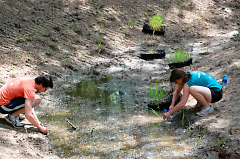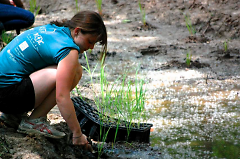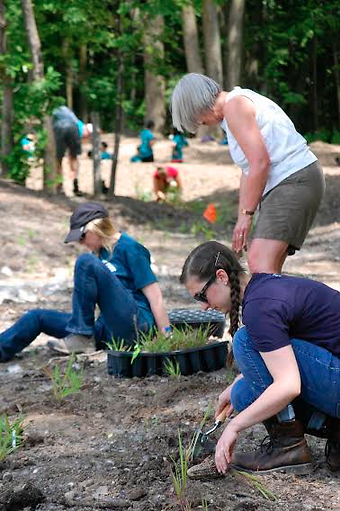Written by Michael Ryskamp (with assistance from Andre Otte and Gail Heffner)
Re-thinking Plaster Creek
I was 3 years old when I took my first fish off a hook, and I’ve been an avid fisherman ever since. I started out with worms and bobbers in the inland lakes of West Michigan. Eventually in high school, I began fly-fishing for trout, traveling to the Rogue River, the Pere Marquette or the Muskegon River to get my angling fix. I lived just a short walk away from Plaster Creek, but there I was spending an hour in a car to find a fishable river. What should have been an asset to me, my friends and the community I grew up in- a healthy stream in which we could fish, swim and play- was instead a liability, something to be avoided and left untouched. Looking back I really didn’t think of Plaster Creek as a stream. To me, it had always been more of a drain. Unfortunately, I had never pictured it as a thriving ecosystem nor realized that it had been degraded over time as modern Grand Rapids was built and as the city’s neighborhoods, infrastructure and local economy were established.
Today the pollutants found in the stream come from a variety of sources: sediment from run-off and from in-stream erosion, excess nutrients from fertilizers and E. coli bacteria from unknown sources. But there is one pollutant that is a trigger for all the others: stormwater. Like most cities, stormwater in Grand Rapids is guided into drains and in southeast Grand Rapids, most of these drains empty into Plaster Creek. The rainwater that flows over our roads, fields, lawns, rooftops and parking lots quickly finds its way into Plaster Creek, along with all the dirt, fertilizer, oil, heat and debris that stormwater run-off carries with it.
Don't touch the creek!
Though many pollutants accompany stormwater into Plaster Creek, one in particular gives the stream the status of unfit for partial body contact: E. coli bacteria. This designation for streams is established by the Environmental Protection Agency (EPA) and is based on a threshold of 300 colony forming units per 100mL of stream water. In other words, if too many colonies of bacteria show up in the petri dish, the creek is deemed unsafe to touch. Segments of Plaster Creek have been measured to contain 13,000 colonies of E. coli per 100mL of stream water. This is a level of contamination over 40 times higher than the acceptable level for partial body contact and 100 times higher than the acceptable level for full body contact. It is uncertain where all of the E. coli are coming from, but we do know that stormwater is a trigger, as we see concentrations of E. coli skyrocket after a rainstorm.
What can be done?
Plaster Creek is still decades away from being a healthy stream again. In order for that to happen, we must first change the way we think about stormwater. The current paradigm sends stormwater into streams as fast as possible, and the subsequent water that enters the stream is too warm and too contaminated. But a new paradigm is emerging and its motto is “slow it down and soak it in.” It aims to treat stormwater where it lands. It is a way of dealing with stormwater that opens up the possibility of one day having a creek that is an asset to our community and not a liability.
There are many ways to slow down and soak in stormwater. Many churches, schools and businesses in the Plaster Creek Watershed have started working to capture stormwater by building rain gardens, constructing bio-swales, installing rain barrels or green roofs and otherwise stalling the process of rainwater flowing from where it lands to the stream. The native plants used in the rain gardens and bio-swales (gardens and trenches designed to capture stormwater) have deep root systems that help clean and cool stormwater, and they act as sediment traps for dirty water that would have clouded the stream itself. The result is a much more natural process that mimics the way rainwater cycles through ecosystems, through the natural filters within the land. Wetlands, soils, roots, microbes and other elements of ecosystems all play a role in filtering stormwater and buffering streams from stormwater surges. Though only a few days old, this bio-swale in the video above is already capturing the stormwater flowing off a two acre parking lot, slowing it down as it meanders and giving it time to percolate into the ground. This bio-swale will do an even better job of capturing stormwater once the native plants are fully established and their roots have grown deep into the soil.
To facilitate the restoration of Plaster Creek or any urban waterway, we must change public perception from wanting water to flow away as quickly as possible to slowing it down, capturing it on site and letting it infiltrate and soak in gradually. It is still possible to reverse the effects of pollution caused by years of stormwater running directly into the creek, but it will take many years of concerted effort and many people working together- in essence, a watershed-wide effort. Every drop of stormwater captured and prevented from flowing into the stream contributes to the restoration of Plaster Creek, which contributes to the restoration of the Grand River.
The Rapidian, a program of the 501(c)3 nonprofit Community Media Center, relies on the community’s support to help cover the cost of training reporters and publishing content.
We need your help.
If each of our readers and content creators who values this community platform help support its creation and maintenance, The Rapidian can continue to educate and facilitate a conversation around issues for years to come.
Please support The Rapidian and make a contribution today.



